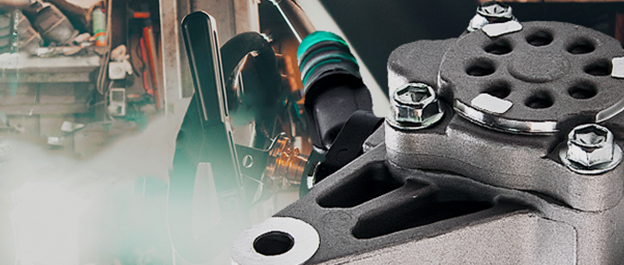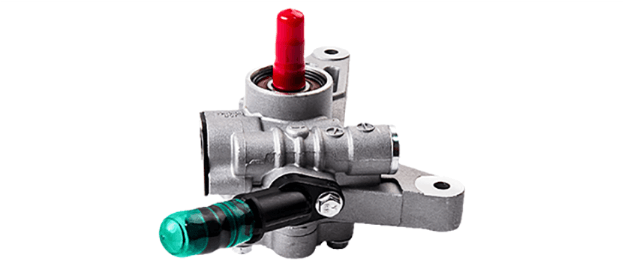Buying a steering pump for your car can sometimes be a daunting and confusing task. At maxpeedingrods.com, it is our mission to make that task as an easy and painless as possible. This Buyer's Guide is designed to answer any questions you may have during your search for the right steering pump for your car, and how to buy steering pump on our website.
What is a steering pump?
The power steering pump is driven by the engine's crankshaft via a belt-pulley mechanism. The pump is
usually located in the front of the engine, adjacent to the alternator or AC compressor. The steering
pump compresses the hydraulic fluid at a rate directly proportional to the speed of the engine. The pump
is built as such to provide the required pressure in different engine conditions such as idling or
running at high speeds.
All steering pumps are equipped with a rotor; the designs of the rotor's fins
are what determines their type. Based on the design of the rotor's fins, the classification is as
follows:
These are the most common kinds of pumps used in automobiles. The vanes are mounted on the rotor such that they touch the housing wall. The power steering fluid is caught between the vanes, the rotor and the housing wall.
• Roller Steering Pump:Roller steering pumps, as the name signifies, have rollers that ride along the inner contour of the pump. The rotor has wide V-shaped grooves cut into its sides. The rollers are pushed to the outer edge of the pump's housing by means of centrifugal force. This action traps the power steering fluid and compresses it.
• Slipper Power Steering Pump:These types of power steering pumps contain springs attached to the rotor. The springs have slippers fitted on their tops and the slippers are in continuous contact with the pump's wall. The pressure build-up inside the pump causes the fluid to be compressed.
What is the function of steering pump?
A power steering pump provides the required hydraulic pressure to steer your automobile with a minimal effort on the steering wheel. When the engine is running, the power steering pump's rotor, which is connected to the pulley, turns. The spinning rotor pressurizes the fluid and delivers it to the steering gearbox. The pulley has open grooves on its sides that mesh precisely with the rubber belt. A rotary valve, torsion bar and a spool valve assembly are other components involved in directing the steering fluid from the pump in the appropriate direction based on the rotation of the steering wheel.
How to buy a steering pump?
You can find your power steering pump by entering your vehicle's year, make and model, If for any reason you cannot, you can find it by its Original Equipment Manufacturer (OEM) number. The OEM part number can be found directly on the part itself. You can also call a dealership with your VIN, and they will provide you with the OEM part number. You can contact one of our car specialists through our website for further assistance in purchasing your steering pump parts.
Why buy steering pump at MaXpeedingRods?
MaXpeedingRods has been engaged in the research of overseas racing products and culture for
decades. If you are looking for steering pump, you have landed at the right place. On the basis
of your vehicle make and model, you can choose from a plethora of automotive maintenance and
accessories. MaXpeedingRods offers a seamless online shopping experience and the streamlined
e-commerce interface makes it easy for you to find just the steering pump you want.
MaXpeedingRods offers a variety of steering pumps with high quality.

What the symptoms of bad steering pump?
Power steering pumps will last for a while but they don't usually last for the lifespan of the vehicle itself. Eventually, the power steering pump in your vehicle is going to go bad and stop doing the job that it is supposed to do. There are plenty of symptoms that will occur when this starts to happen. Below are the top 5 symptoms to look out for when the power steering pump goes bad.
Difficulty Turning Wheel.The most common symptom you will experience is when you have difficulty turning the steering When you go to make a turn, the steering wheel will feel very stiff and you'll have to use a lot of strength and force just to make a basic turn. This should prompt you to check the power steering pump because it could mean that it needs replacing.
Whining Noise.When you try to turn your steering wheel, you might hear a whining noise. This is an indication that a problem exists inside of your power steering system. The whining noise could be due to many reasons, one of which being that the power steering pump has a leak in it. Either that or the power steering fluid might be too low. But you'll want to check on both just in case.
Squealing Noise.A squealing noise might be heard when you first turn on your vehicle's engine. This noise will remain consistent for about a minute after the car is started. The reason for this likely has to do with a bad power steering pump that is making the belt inside the system slip. This means you must replace the pump and realign your belt.
Groaning Noise.This is the worst noise of them all. If you have neglected to repair or replace your already dysfunctional power steering pump, it will eventually make groaning noises. This usually occurs if there is a leak or insufficient fluid going through the pump, which will ultimately ruin the whole power steering system. Not only will you have to replace the pump at this point, but you may have to replace the whole system as well.
Chrome Flakes in Fluid.Checking the power steering fluid can tell you a lot about the condition of the power steering pump. Aside from assuring there is an adequate amount of power steering fluid in the system, you'll also want to check to see the color and condition of the fluid. If you see dark gray colors or chrome flakes in the fluid, then it means your pump is degraded.

How to install a steering pump in a car?
In many cases, the power steering pump will not function because the serpentine or drive belt is broken and needs to be replaced. It's also common for the power steering pulley to break or wear out. If you notice these symptoms and have inspected the power steering pump, replacing this component is the best course of action. This job is rather simple to complete, but you should always read the exact procedures your vehicle manufacturer recommends in the service manual.
Materials Needed:
• Hydraulic line wrenches
• Pulley removal tool
• Boxed end wrench or ratchet wrench
• Drain pan
• Replacement power steering drive or serpentine belt
• Replacement power steering pulley
• Replacement power steering pump
• Safety equipment (safety glasses & plastic or rubber gloves)
• Shop rags
• Threadlocker
According to most experts, this job should take about two or three hours to complete. Make sure you
give yourself enough time to work on this project and try to complete it all on the same day to
avoid missing steps.
Before you start on this job, make sure you have a good supply of shop rags placed under all
hydraulic lines that you might remove. Hydraulic fluid is very difficult to remove from metallic
components and the hoses will leak when you remove them.
Before removing any parts, locate the vehicle's battery and disconnect the positive and negative
battery cables.
This step should always be the first thing you do when you work on any vehicle.
Do this with a hydraulic lift or jacks and jack stands.
Step 3: Remove the engine cover and ancillary parts.
This will give you clear access to the power steering pump.
Most vehicles have easy access to the power steering pressure switch while others require you to
remove a few components including: engine cover, radiator fan shroud & radiator fan, air intake
assembly, alternator, AC compressor, and harmonic balancer.
Always refer to the vehicle's service manual for exact instructions on what you need to remove.
To remove the serpentine belt, loosen the tensioner pulley that is located on the left side of the
motor (as you're looking at the motor).
Once the tensioner pulley is loose, you can slip the belt off rather easily. If your power steering
pump is driven by the drive belt you'll have to remove this belt as well.
On most domestic and foreign cars, there are one or two engine covers underneath the engine.
This is commonly known as a skid plate. To gain access to the power steering pump lines, you'll have
to remove these.
This gives easier access to the power steering pump, pulley and supporting lines that need to be removed.
Step 7: Disconnect lines going into power steering pump.
Using a socket and ratchet or a line wrench, remove the hydraulic lines that are connected to the
bottom of the power steering pump.
This is usually the supply line that is connected to the gear box. Make sure you place a drip pan
under the vehicle before attempting this step as power steering fluid will drain.
Let it drain from the pump for a few minutes.
Step 9: Remove the mounting bolt underneath the power steering pump.There is usually a mounting bolt that connects the power steering bolt to either a bracket or the engine block. Remove this bolt using a socket or end wrench. • Note: Your vehicle may not have mounting bolts located underneath the power steering pump. Always refer to your service manual to determine if this step is needed for your specific application.
Step 10: Remove the additional hydraulic lines from the power steering pump.
Once you've removed the primary supply line, remove the other attached lines.
This includes the supply line from the power steering reservoir and the return line from the gear
box. Some vehicles have an electrical harness attached to the power steering pump. If your vehicle
has this option, remove the harness at this point of the removal project.
In order to successfully remove the power steering pump pulley, you'll need to use the right tool.
This is often referred to as a pulley removal unit. The process for removing the pulley is noted
below, but you should always read the manufacturer's service manual for their recommend steps.
This involves attach pulley removal tool to the pulley and guide the locking nut onto the edge of
the pulley. Using a socket and ratchet, slowly loosen the pulley while holding the pulley attachment
nut with a corresponding end wrench.
This process is very slow, but necessary in order to correctly remove the power steering pulley.
Continue loosening up the pulley until the pulley has been removed from the power steering pump.
Using an impact wrench or regular socket and ratchet, remove the bolts holding the power steering
pump onto the bracket or the engine block.
Usually there are two or three bolts that need to be removed. Once this has been completed, remove
the old pump and take it to a workbench for the next step.
Most replacement power steering pumps do not come with a mounting bracket for your specific vehicle.
This means you'll have to remove the old bracket from the older pump and install it onto the new
bracket. Simply remove the bolts that secure the bracket to the pump and install on the new pump.
Make sure to install these bolts using threadlocker.
Anytime you install a new power steering pump, you need to install a new pulley and belt.
The process for installing this unit is exactly opposite from the removal and is noted below for
your review. As always, refer to your vehicle service manual for specific steps as they will vary
for each manufacturer.
Secure the pump to the engine block by screwing bolts through the bracket to the block.
Step 16: Install new pulley using the pulley installation tool.Attach all hydraulic lines to the new power steering pump (including bottom supply line).
Step 17: Reinstall remaining parts.
Reinstall all parts removed to give better access.
Reinstall new serpentine belt and drive belt (refer to manufacturer's service manual for proper
installation procedures).
Reinstall radiator fan and shroud, lower engine covers (skid plates), and any parts you had to
remove initially in the exact opposite order you removed them.
Before you finish the job,make sure to remove all tools,debris,and hardware from under the vehicle to avoid running over them with your vehicle.
Step 20: Reconnect battery cables. Test driving the vehicle Test driving the vehicleAfter you've reinstalled all components that have been removed and you've filled the power steering fluid to the “full” line, you need to prime the power steering system. This is best completed by starting the engine while the front wheels are in the air.
Step 1: Prime the power steering system.
Start the vehicle and turn the steering wheel to the left and right a few times.
Shut off the motor and refill the power steering fluid reservoir. Complete this process until the
power steering fluid reservoir does not require refilling.
A good road test of 10 to 15 miles is recommended when you've replaced the power steering pump.
Start the vehicle first and inspect underneath the vehicle for any leaks before you take the vehicle
on any road test.







